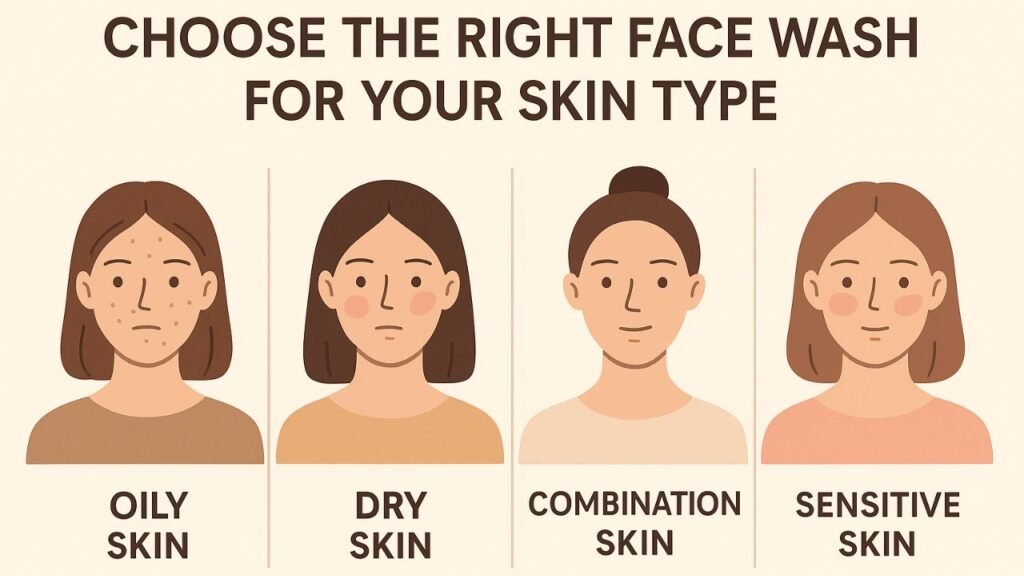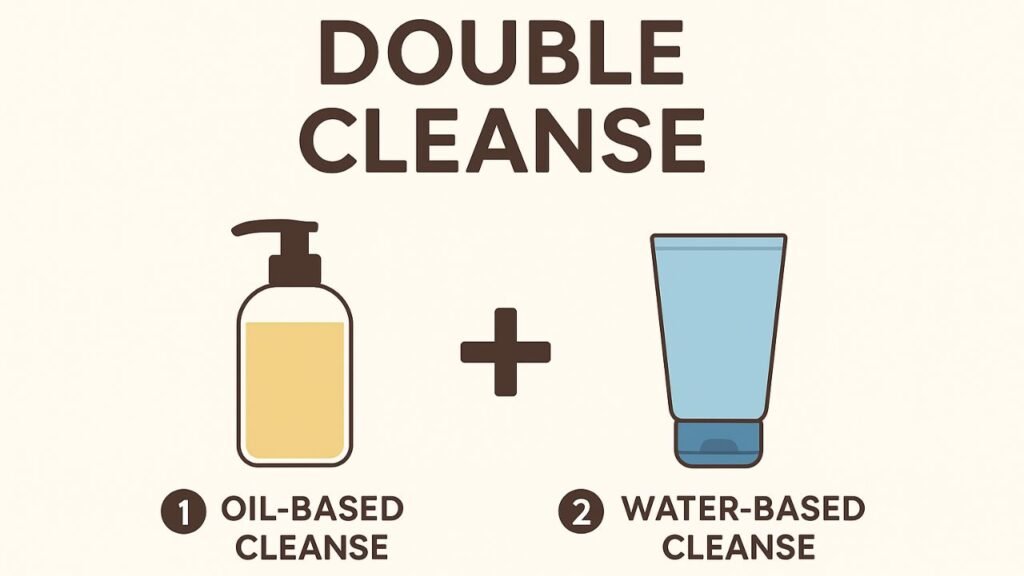Face washing seems simple—splash some water, rub in a face wash, rinse, and you’re done. But that’s only the surface-level truth. In reality, how you wash your face plays a big role in your skin’s health, texture, hydration, and long-term aging.
Dermatologists often say that cleansing is the foundation of skincare, and getting it wrong can trigger acne, dryness, irritation, or premature wrinkles.
Whether you’re a skincare beginner or someone looking to refine your routine, this comprehensive guide will walk you through the best face wash tips, common mistakes, ideal techniques, and product recommendations for different skin types.
Table of Contents
Why Face Washing Matters More Than You Think
Before diving into specific tips, it’s important to understand why proper cleansing is so important.
Your skin is exposed to pollution, dust, sweat, bacteria, and skincare/makeup products throughout the day. When these accumulate, they clog pores, contribute to acne, and create a dull complexion.
Cleansing removes these impurities, allowing your skin to breathe and absorb other skincare products more effectively.
Proper cleansing also:
- Maintains the skin’s natural pH balance
- Prevents excess oil buildup
- Reduces the chances of fungal and bacterial growth
- Keeps pores clean and minimized
- Helps your skin barrier stay healthy and resilient
In short, face washing is not just a hygienic habit—it’s a form of basic skincare therapy.
20 Best Face Wash Tips
1. Choose the Right Face Wash for Your Skin Type
One of the biggest mistakes people make is using a face wash that doesn’t suit their skin type.

For Oily Skin
Look for:
- Gel-based or foam cleansers
- Oil-free formulas
- Ingredients like salicylic acid, niacinamide, tea tree, clay, or charcoal
Avoid heavy cream-based cleansers that may clog pores.
Why: Oily skin produces excess sebum, so a clarifying cleanser helps control shine and prevent acne.
[Also Read: 7 Best Face Wash for Oily Skin For Men]
For Dry Skin
Look for:
- Cream or lotion-based cleansers
- Hydrating ingredients like hyaluronic acid, ceramides, squalane, and glycerin
Avoid foaming cleansers with sulfates.
Why: Dry skin benefits from a gentle, moisturizing formula that cleans without stripping natural oils.
For Combination Skin
Look for:
- Balancing or pH-neutral gel cleansers
- Gentle foams
Avoid overly harsh formulas that dry out the cheeks but fail to control oil in the T-zone.
For Sensitive Skin
Look for:
- Fragrance-free formulas
- Hypoallergenic cleansers
- Calming ingredients like aloe, chamomile, oatmeal, or panthenol
Avoid exfoliating cleansers, alcohol, sulfates, and strong fragrances.
For Acne-Prone Skin
Look for:
- Salicylic acid (BHA)
- Benzoyl peroxide (in mild concentration)
- Tea tree oil
- Non-comedogenic labels
Avoid oily or creamy products that may clog pores.
2. Wash Your Face Twice a Day—Not More, Not Less
Many people either under-cleanse or over-cleanse. Both can harm the skin.
Morning Cleansing
Cleansing in the morning removes overnight sweat, oil, and bacteria from your pillowcase. It also preps your skin for morning skincare like sunscreen.
Night Cleansing
This is the most important cleanse of the day. It removes:
- Makeup
- Pollution
- Dust and bacteria
- Sunscreen
- Excess oil from the day
Avoid Washing 3–4 Times a Day
Over-cleansing strips natural oils, causing:
- Irritation
- Redness
- Increased oil production (rebound effect)
- A compromised skin barrier
Twice daily is ideal for most people, except those with extremely dry or sensitive skin, who may cleanse only once at night.
3. Always Wash Your Hands First
Your hands carry dirt, bacteria, and oils. Washing your face with dirty hands transfers all of it onto your skin.
Start your skincare routine by cleansing your hands thoroughly. This simple habit reduces acne-causing bacteria and ensures a cleaner wash.
4. Use Lukewarm Water—Not Hot or Cold
Water temperature plays a huge role in cleansing.
Hot Water
❌ Strips natural oils
❌ Causes dryness and redness
❌ Can trigger inflammation and broken capillaries
Cold Water
❌ Doesn’t dissolve oil or remove dirt effectively
Lukewarm Water
✔ Gently dissolves oils
✔ Cleans effectively
✔ Comfortable for most skin types
✔ Preserves the skin’s moisture barrier
Make this your face-washing default.
5. Don’t Apply Face Wash Directly on Dry Skin (Unless It’s Oil-Based)
Most water-based or foaming cleansers should be applied on damp skin, not dry skin.
Why?
- Damp skin helps the face wash spread evenly
- It improves lathering
- It ensures gentler cleansing
- It reduces friction, preventing irritation
Exception: Oil cleansers should always be applied on dry skin for proper makeup and sunscreen breakdown.
6. Massage Gently for 20–30 Seconds
Rushing through face washing is common but ineffective.
Cleansers need time to break down oil, dirt, and sunscreen.
Avoid:
- Scrubbing aggressively
- Rubbing harshly
- Using too much pressure
These actions damage the skin’s barrier and can cause microtears.
Do:
Use circular, gentle upward motions for at least 20–30 seconds.
This promotes:
- Better cleansing
- Improved blood circulation
- A relaxing skincare ritual
7. Avoid Using Bar Soap on Your Face
Body soaps are too harsh for delicate facial skin.
They:
- Have high pH levels
- Strip natural moisture
- Cause tightness and irritation
- Can clog pores
Always use a cleanser specifically meant for the face.
8. Double Cleanse if You Wear Sunscreen or Makeup
Double cleansing is one of the most effective cleansing methods.

Step 1: Oil-Based Cleanser
Removes:
- Makeup
- Sunscreen
- Waterproof formulas
- Excess sebum
Step 2: Water-Based Cleanser
Removes:
- Sweat
- Dirt
- Impurities
- Residual oil
Double cleansing ensures deep cleaning without over-drying — making the skin fresh and ready for serums.
9. Don’t Over-Exfoliate While Washing
Some cleansers contain exfoliants like salicylic acid, glycolic acid, or physical microbeads.
Using them daily can cause:
- Redness
- Sensitivity
- Microtears
- Irritation
General Rule:
- Chemical exfoliating cleansers: 2–3 times per week
- Physical scrubs: once a week (or avoid them altogether)
Be mindful of not combining too many exfoliating products.
10. Use a Clean, Soft Towel to Pat Dry
How you dry your face matters.
Avoid:
❌ Sharing face towels
❌ Using rough or dirty towels
❌ Rubbing your skin aggressively
Do:
✔ Use a designated, clean face towel
✔ Replace every 2–3 days
✔ Pat gently, don’t rub
This prevents irritation and reduces bacterial transfer.
11. Apply Skincare Products Within 60 Seconds of Washing
This is known as the “moisture window” or “golden minute”. After washing, your skin begins to dry fast.
Applying skincare products like serums and moisturizers within 1 minute:
- Locks in hydration
- Improves absorption
- Strengthens the moisture barrier
For dry skin, this step is especially important.
12. Avoid Using Too Many Cleansers in One Routine
Some people mix cleansers—like a foaming cleanser followed by an exfoliating one.
This may:
- Over-cleanse
- Strip moisture
- Irritate the skin
Stick to one cleanser per wash (unless double cleansing at night).
13. Pay Attention to Fragrances and Alcohol
Fragrance can irritate sensitive and acne-prone skin.
Alcohol-based cleansers may:
- Dry out the skin
- Strip moisture
- Trigger oil overproduction
Choosing fragrance-free, alcohol-free cleansers is safer for long-term skin health.
14. Adjust Your Cleansing Routine According to the Season
Your skin changes with the weather.
Summer
- Increased oil production
- Sweat and dirt buildup
- Need for gel or foam cleansers
- More frequent double cleansing
Winter
- Dryness and tightness
- Switch to hydrating, cream-based cleansers
- Avoid hot water
- Add moisturizing ingredients
Adapting your face wash helps your skin stay balanced year-round.
15. Check Ingredient Labels Carefully
Knowing what goes into your cleanser helps avoid irritation and pick the right formula.
Good Ingredients:
- Ceramides
- Hyaluronic acid
- Niacinamide
- Aloe vera
- Panthenol
- Squalane
Ingredients to Avoid (if sensitive):
- Sulfates (SLS/SLES)
- Parabens
- Artificial fragrance
- Alcohol denat
- Essential oils (for some people)
16. Replace Your Cleansers Every 6–12 Months
Like all skincare products, cleansers expire.
Old cleansers may:
- Lose effectiveness
- Grow bacteria
- Irritate the skin
Regularly check the expiration date and storage instructions.
17. Don’t Expect Instant Results
Cleansing is a maintenance step. It won’t magically remove acne or hyperpigmentation by itself.
Its benefits are subtle but essential:
- Cleaner pores
- Brighter complexion
- Better absorption of serums
- Stable moisture barrier
Think of cleansing as preparing the skin for real transformation through treatments like vitamin C, retinol, or niacinamide.
18. Customize Your Routine Based on Your Lifestyle
Your lifestyle influences how often and how deeply you should cleanse.
If you exercise daily:
Always wash your face after workouts to remove sweat and bacteria.
If you work in polluted environments:
Consider double cleansing at night.
If you have extremely dry skin:
You may skip the morning cleanser and splash water instead.
If you use heavy makeup/sunscreen:
Double cleanse without fail.
19. Avoid Cleansing Wipes as a Replacement for Face Wash
Face wipes:
- Don’t cleanse deep into pores
- Leave residue
- Contain irritants
- Cause friction on the skin
Use them only when you absolutely have no access to water.
20. Pay Attention to Post-Cleansing Feel
Your cleanser should leave your skin feeling:
- Clean
- Soft
- Comfortable
It should not feel:
- Tight
- Squeaky
- Dry
- Itchy
If your skin feels stripped, your cleanser is too harsh—switch to a gentler formula.
Conclusion: Cleansing Is Simple, But Doing It Right Makes All the Difference
Face washing might seem like a small step, but it’s the foundation of your entire skincare routine. With the right cleanser, proper technique, and consistent habits, you can dramatically improve your skin’s health, clarity, and texture.
Following these tips will help you:
- Prevent acne
- Maintain hydration
- Strengthen your skin barrier
- Achieve a glowing, balanced complexion
Cleansing isn’t about doing more—it’s about doing it better.

